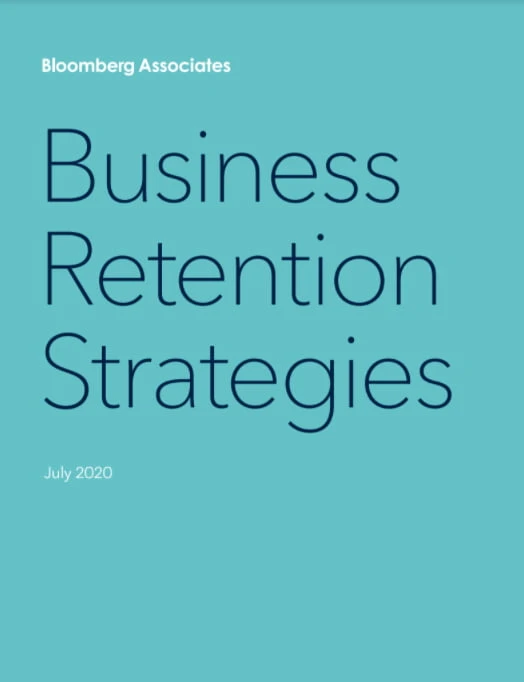COVID-19 Economic Response and Recovery
Create a Business Retention Advisory Council and Key Accounts Team

Consider the following stakeholders for an advisory council: city/ county and/or state economic development organization, metro chamber of commerce, retired business executives, city and/or state government official, utility representative, education entity, financial institution, professional services company, business owner/operators. Council members should be chosen for their skills, knowledge, expertise and connections.
Staff your key accounts team with key account managers from your economic development organization, chamber of commerce and/ or government officials. Each target business should have a key account manager, who is always available for the business to contact and should touch base at a regular interval (every 3–6 months). Ideally, the key account manager would have actively worked to land the project and has a relationship with senior management of the business.
It will also be important for the key accounts team — with the advisory council’s help — to build meaningful partnerships with organizations which can make a significant contribution to the program’s success, for example the Mayor/ city administrator, chamber of commerce, state economic development agency, local economic development organization, and other supporting organizations, which are willing to collaborate for the greater good.
Learn more about Business Retention Strategies
Visitations are particularly helpful for identifying at-risk businesses, or those that are considering contraction, closing or relocation.
Visits should be centered on understanding the businesses’ concerns and needs and learning how the public sector might be able to support the business.
Your focus should be on both urgent problems for the local employer, as well as longer-term plans to improve the local business climate. You can also use the visit to make the business aware of any US Workforce Innovation and Opportunity Act (WIOA) dollars that can be used for staff training.
Learn more about Business Retention Strategies
Periodically, survey your local employers to better understand their current and projected needs in areas such as declining consumer/business demand, transportation, workforce development, and regulatory issues. Your key accounts team should also serve as a touchpoint for information and warnings about any potential problems.
Key Questions Might Include:
- What challenges are you currently experiencing?
- What information or assistance could you use?
- What business assistance have you used or plan to use?
- Do you plan to reduce/ expand operations, etc.
Learn more about Business Retention Strategies
Standing out:
Finally, the current crisis is creating opportunities to stand out from the crowd.
Communicate that you have a plan, are responding quickly, and working as one team.
Continue to communicate your city’s positive attributes and trends and your supports for local businesses. Also, explain how you are continuing to invest in the city’s underlying strengths (infrastructure, transportation, talent pipeline, workforce skills, science base, etc,) and that you hope to emerge more sustainable, equitable and resilient.

Learn more about Business Retention Strategies
COVID-19 Economic Response and Recovery
Address Target Employers’ Needs by Sharing Information, Providing Support and Finding Solutions to Problems
Background
Site visits should be followed up within 24 hours with a communication outlining how you plan to address the employers’ needs — for example, by sharing information and advice, unblocking an obstacle, and/or providing access to assistance, contacts, networks and/or a sales opportunity.
Examples of Supports Include:
- Information: Providing access to economic data and demographic information
- Providing information and advice on the availability of appropriate buildings and sites
- Providing information and assistance on regulations and permits
- Technical assistance: Providing access to technical assistance programs, e.g. to increase firm efficiency
- Providing support/funding to restructure for a post-pandemic economy
- Access to funding: Providing access to tax exemptions and incentives for retention/expansion
- Workforce training: Providing access to training dollars to train the business’ employees
- Access to talent: Providing opportunities to shape talent pipeline plans
Providing access to graduate students - Innovation support: Facilitating research collaborations
- Facilitating support for product development, innovation and/or collaborations with tech startups
- Supply chain support: Facilitating access to local suppliers (and supporting those suppliers to deliver scale and quality)
- Access to markets: Providing marketing assistance (e.g. use your website and social media channels to promote local businesses)
- Identifying opportunities to sell goods and services to the city
- Providing support to enter new sales channels (e.g. overseas)
- Lobbying: Making a case to city officials to reform/relax land use planning, zoning and/or building regulations, local ordinances and/or permitting rules where these are no longer fit for purpose for a pandemic/post-pandemic economy
- Helping local management make the case to HQ why the local office/ plant should be retained, or expanded
- Lobbying state and federal officials for supportive policies and programming
- Corporate social responsibility opportunities: Identifying ways in which the business can support the city’s crisis response, for example, by connecting a business to charities and nonprofits; or asking it to provide pro-bono training or technical assistance for small business owners.
Benefits of a business retention visitation program:
- Identification of at-risk companies
- Identification of business issues and concerns impacting competitiveness
- Updating of data including employment levels and recruitment/ retention issues
- Discovery of future plans for contraction, closing, or expansion and capital investment
- Establishment of an ongoing communication process
- Making employers aware that they are a valued part of the community
- Indicating the willingness of the city to work with firms and solve problems
Use a CRM tool, such as free HubSpot, or Salesforce for Economic Developers to manage your relationship with the employer, and record the program’s impact.
Consider asking around to see which CRM tool your state and/ or regional EDO partners use. By using the same platform as key partners, it may be easier to share and integrate data.
Learn more about Business Retention Strategies
COVID-19 Economic Response and Recovery
Become an Information Clearinghouse and Provide Access to Contacts and Networks
Action
Strive to become a trusted adviser to the employer, as well as a single repository of the information and technical assistance that the employer needs. It should be your aim to be able to introduce the business to anyone in the city, find the answer to any of the business’ questions, and identify the opportunities which can support the business’ local operations. A good way to build a relationship is to educate your employers about federal and programmatic dollars which they can access.
Provide regular networking opportunities for local employers, for example, business roundtables with the Mayor/council members/senior officials, networking lunches, and meetings with local banks and university heads, etc.

Learn more about Business Retention Strategies
COVID-19 Economic Response and Recovery
Create a Database of Existing Employers, to Which You Will Target your Efforts
Your business retention program will focus on:
- Large corporate employers – which provide major capex and job creation numbers for your economy
- Smaller and medium sized businesses – which make up the baseline of your city’s economy.
Your target employers should be businesses which create large numbers of good and promising jobs for local residents (and, from an equity perspective, jobs that don’t require bachelor’s degrees).
Brookings Institution defines “good and promising jobs” here. These are jobs that pay the median wage for sub-baccalaureate workers, and provide stable employment and employer-sponsored health insurance. (US metro statistical area median wage figures can be found here.)
“Good job” employers are likely to be concentrated in maintenance, construction, production, transportation, management, business, computer, engineering and healthcare industries.

You may also want to target:
- Businesses which have received incentives in the past
- Businesses which are likely to thrive in a postpandemic economy and during a significant economic downturn (e.g. because of limited disruption to their personnel, operations, supply chains or revenue; or demand for their goods/ services is relatively inelastic; or their products might need to be “near-sourced” in the future)1
- Businesses in industries in which the city has a competitive advantage (for US county location quotient data, see here)
- Businesses which are in emerging industries, or are doing unique and innovative things, which may be growth opportunities for your city; and/or
- Businesses in industries which have a lower share of tasks that are susceptible to automation (see here)
- Businesses in priority neighborhoods: Pay special attention to small businesses that employ between 10 to 99 employees, which are often major drivers of local job growth
Many consulting firms, ratings agencies, think tanks and academic institutions are publishing research and insights on this topic, for example, Moody’s Analytics, McKinsey, Avasant. Their work is constantly being refined as the crisis progresses and better data becomes available.
If you have limited resources, segment your employers as follows:
- 50x priority 1 employers, which will be account managed
- 200x priority 2 employers, which will receive surveys and lighter touch support.
Choose whether to separate out tourism and hospitality businesses, if they can be supported better by your local destination marketing organization/convention bureau.


